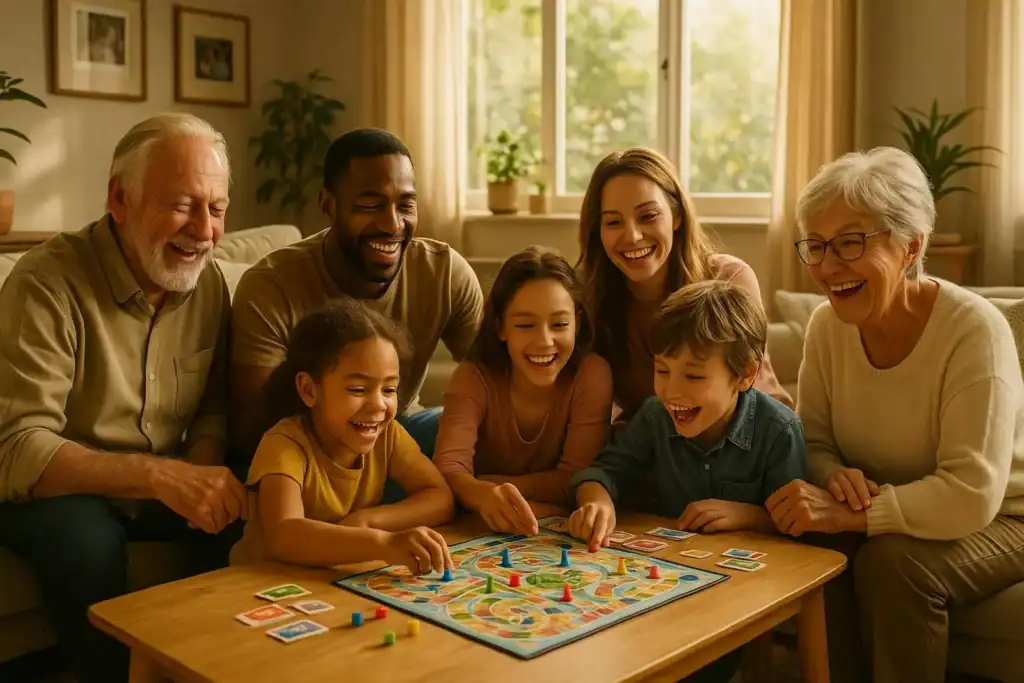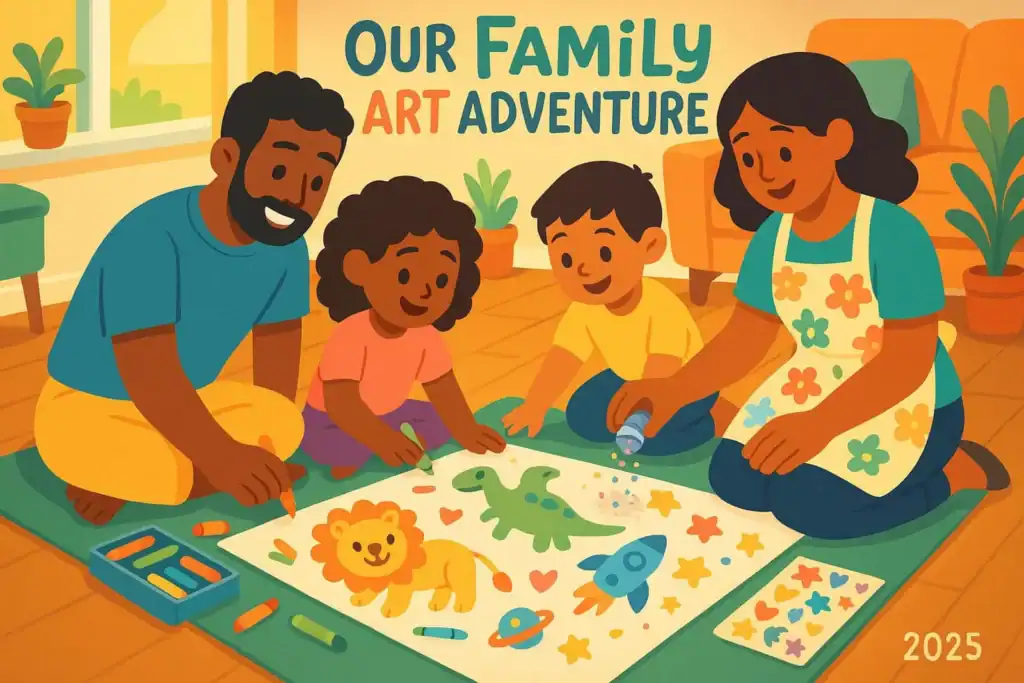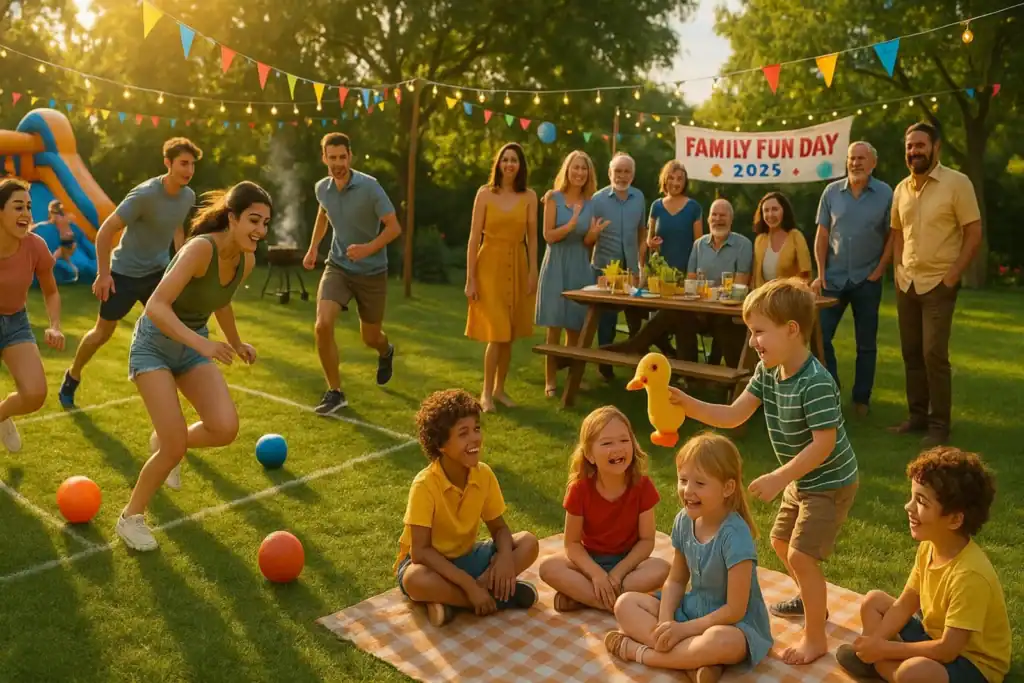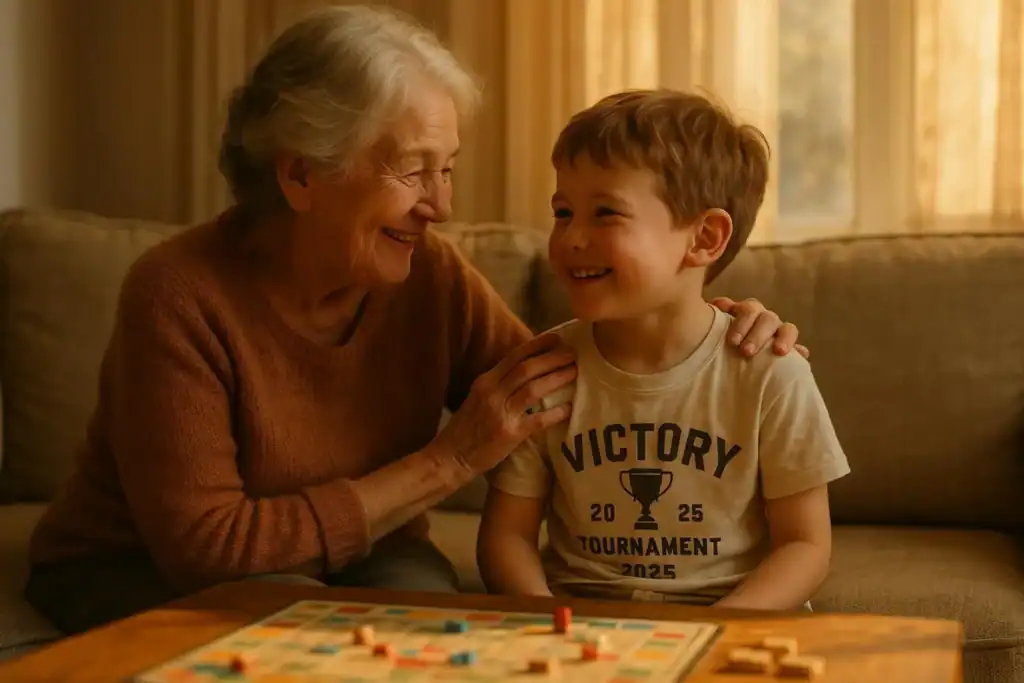Family-friendly party games are activities that bring fun to people of all ages, from toddlers to grandparents. These games welcome everyone, no matter their age or skill level, so the whole group can join in. They focus on laughs, connection, and shared moments, and they work well for birthdays, holidays, or casual hangouts.
Unlike games made for a narrow age range, these options are simple to pick up and enjoy. They help kids and adults play together, share jokes, and enjoy light competition. The aim is a happy group experience that builds memories and brings people closer.

What Are Family Friendly Party Games?
These games are about having fun together. They use easy rules and age-safe themes so everyone can play. Instead of heavy strategy or tricky content, they rely on simple ideas, creativity, and friendly play.
Good family games also bend to fit your group. They can be loud and active or calm and quiet. Whether it’s a backyard relay or a living room guessing game, the point is to share a good time and a sense of togetherness.
Key Features of Family Friendly Party Games
- Simple rules: Kids and adults can learn them fast, so play starts quickly.
- Inclusive themes: Content stays clean and broad so no one feels out of place. For example, with Monikers (a modern spin on “Celebrities”), you can remove any cards you don’t want to use.
- Lots of interaction: These games get people talking, teaming up, and laughing. Winning matters less than having fun together.
Benefits of Playing Party Games as a Family
These games create quality time. They pull people away from screens and into face-to-face play. Kids practice taking turns, teamwork, and fair play. Adults get to relax and be playful.
Many games spark creativity, problem-solving, and quick thinking, all while feeling like pure fun. Shared wins, silly moments, and inside jokes turn into stories your family will keep for years.
What Makes a Game Suitable for All Ages?
The best all-ages games are easy to learn and fun for older players too. They avoid complex rules, long reading, or heavy strategy. They also adjust easily for different skills or physical abilities.
For example, you can tweak Musical Chairs by swapping in cushions if space is tight, or slowing the music for younger kids. Content stays age-appropriate and interesting for everyone. A good all-ages game gives every player a way to join in and feel part of the fun.
Categories of Family Friendly Party Games
There are many types of family games, so you can match them to your space, mood, and group size. Some get everyone moving, others boost creativity, and some test quick thinking. Pick a few types to keep things fresh and fun.
Some games need almost no supplies, while others need a few props or a bit of setup. Choose the kinds that fit your group’s tastes and your party space for the best results.
Active and Outdoor Games
When you have room to move or nice weather, active games help use up energy. Freeze Tag needs no gear and gets everyone running. Hide-And-Seek works in many places; try playing near dusk for extra excitement. Red Light/Green Light is simple and fast.
For team play, try Capture the Flag or Tug-of-War. Cornhole is great for a slower pace. With a pool, play Marco Polo. On hot days, Water Balloon Toss and Slip and Slide bring big smiles. Simple, outdoor-friendly ideas often work best.
Classic and Traditional Games
Some games last for generations because they’re easy and fun. Musical Chairs is a favorite, with fast action when the music stops. Pass the Parcel builds suspense as each layer gets unwrapped.
Simon Says tests careful listening. Charades gets people acting and guessing without words. Telephone shows how a message changes as it travels around the circle. These classics are easy to set up and always bring laughs.
Creative and Artistic Games
If your family enjoys imagination and art, try storytelling or drawing games. Storytime Freeze has one person start a story, then others add parts when the action pauses, pushing quick thinking and creativity.
A Fake Artist Goes to New York blends drawing with guessing who doesn’t know the subject. Set up a Craft Corner with stickers, markers, and glitter so kids can make bookmarks or party hats to take home. Group Artwork, where everyone adds to a shared drawing, helps quieter kids take part in a calm way.

Board and Card Games for Groups
Board and card games give structure and spark friendly rivalry. They’re great indoors and work well when you want a focused activity.
Wavelength is very social: one player gives a clue on a scale (like “cold food” to “hot food”), and the team tries to guess the hidden spot on the scale. Monikers mixes Charades and Taboo across three rounds, and it gets funnier as it goes.
UNO is fast and easy to learn. Scattergories pushes quick thinking by listing words for categories using a set letter. Social deduction games like Mafia/Werewolf keep everyone engaged with roles and bluffing.
Technology-Enhanced and App-Based Games
Phones and tablets can add new ways to play. These games appeal to kids and teens but are simple enough for all ages.
Heads Up! shows a word on one player’s phone, and others act or describe it so they can guess. The Wavelength app brings the board game experience to your screen. Digital tools can speed up play, cut down on setup, and keep the group involved.
How to Choose the Right Party Game for Your Family
Picking the right game means thinking about your guests and your space. A little planning helps everyone feel welcome and excited to join in. A quick check of your group and setting makes a big difference in how much fun you’ll have.
Think like a game host who picks the right mix for your crowd. Aim for games that let different personalities shine and keep the mood light and social.
Consider Group Size and Age Range
How many people you have-and their ages-matters a lot. Small groups do well with board games, art activities, or two-to-four-player games. Big crowds need group games like tag, relays, or team challenges.
Match ideas to ages: – Toddlers: simple, repeatable games like bubbles or a small treasure dig. – Preschoolers: Duck, Duck, Goose or Simon Says. – School-age kids: Musical Chairs, Pin the Tail on the Donkey, or Red Light, Green Light. – Tweens/teens: NERF games, dodgeball, or flag football for action and social time.

For mixed ages, pick games with flexible rules or roles so everyone can join, or split into smaller groups for different activities.
Check Space and Venue Needs
Your space shapes your choices. Look at where you’ll play: a big yard, a small living room, or a rented hall?
With lots of room, try obstacle courses, Backward Race, Three-Legged Race, or Steal the Bacon. Outdoors, Dizzy Bat or Card Ninja (tossing cards at a watermelon) are fun.
With tight space, go for board games, card games, art stations, or guessing games like 20 Questions or Heads Up! You can also adjust active games-use cushions for Musical Chairs to save space. Pick games that feel safe and comfy in your area.
Match Energy Levels and Time Available
Think about the group’s energy and how much time you have. Start with active games if people are excited, and wind down with calmer ones later. Avoid long, high-energy games right after a big meal.
Longer sessions: Treasure Hunts or Balloon Pop Relays. Short windows: Minute to Win It games like One-Handed Penny Stacking or Cookie Face. For a calm mood, try Story Starters or a Memory Game. Keep a mix ready so you can switch if the mood changes.
Accessibility and Inclusivity Considerations
Plan with all abilities in mind. Notice if a game needs lots of running, fine motor skills, or complex thinking, and adjust as needed.
For team games, draw names to form teams instead of having captains pick. Give everyone a turn before repeating choices in games like Duck, Duck, Goose. Offer alternate roles-judge, scorekeeper, or helper-for guests who don’t want or can’t do the physical parts. Set up a coloring table or quiet corner with books or puzzles for anyone who needs a break. Aim for a warm space where every guest feels welcome.
Popular Family Friendly Party Games by Age Group
Matching games to age helps keep everyone engaged. Some games can be adjusted for any age, but certain ideas fit best at certain stages. This helps avoid bored older kids and confused younger ones.
From simple sensory play to tricky trivia, the right choice keeps players hooked and happy.
Games for Toddlers and Preschoolers
Keep it simple, repeatable, and sensory-based. Duck, Duck, Goose gives a gentle chase that little kids love. Musical Chairs works well if you keep it playful.
Bubbles are always a hit. A Treasure Dig in a bin of sand is great fun. Indoors, Freeze Dance and Storytime Freeze mix movement and imagination. Focus on joy, not winning.
Games for School-Age Children
Ages 6-12 enjoy clear rules, light strategy, and some competition. Pin the Tail on the Donkey (or themed versions) always works.
Try Red Light, Green Light and Steal the Bacon for active play. Charades and Pictionary build expression. Telephone brings big laughs. UNO and Apples to Apples Junior add friendly rivalry. Relays and simple obstacle courses are also great picks.
Games for Tweens and Teens
They like games that feel cool, social, and a bit challenging. Active hits include NERF Wars, Dodgeball, and Flag Football.
Indoors, go for quick thinking or social deduction. Heads Up! gets them laughing. Wink Assassin adds mystery. Scattergories (13+), What Do You Meme? Family Edition, and Kids Against Maturity bring humor. Try a Marshmallow Challenge for building, or a Trivia Contest for knowledge. Pick games that move fast and let them team up.
Games for Mixed-Age Groups
Choose simple actions with room for different skill levels. Musical Chairs and Freeze Dance fit all ages. Guessing games like 20 Questions or I Spy rely on thinking, not speed.
Telephone Pictionary mixes drawing and communication for all skill levels. Cooperative games let everyone pull together. Minute to Win It tasks often work for mixed ages and bring lots of laughs.
Best Family Friendly Party Games for Any Occasion
Different events call for different styles of games. The right choice can turn a normal day into a standout memory. Pick games that match the setting and mood.
Whether you’re indoors and cozy or outdoors and active, you can find something that fits. Here are ideas that suit common occasions.
Games for Birthdays and Celebrations
For younger kids, Musical Chairs, Pass the Parcel, and themed Pin the Tail games are great. They build excitement and fit any party theme.
Want more action? Try a Balloon Pop Relay or an Obstacle Course scaled to your space. Creative stations like decorating party hats or cupcakes double as take-home treats. Birthday Trivia about the guest of honor adds a personal touch.
Games for Holidays and Seasonal Events
Holidays often bring big, mixed groups. The Saran Wrap Game, with small treats hidden in layers, builds suspense and works for many themes. The Post It Note Game (guess your identity) helps people mingle.
Seasonal twists are fun: a spooky Treasure Hunt or Monster Mash Freeze Dance at Halloween; Cornhole or Water Balloon Toss in summer; or Name That Tune with holiday songs. Pick games that match the season and bring everyone together.
Games for Indoor Gatherings
In smaller spaces, go with games that fit around a table or living room. UNO is quick and lively. Heads Up! is perfect for laughs in a tight space.
Charades, Pictionary, and Telephone are classic picks. Try 20 Questions or I’m Hosting a Party for a thinking challenge. Minute to Win It games using simple items (pennies, cookies, cups) work well. Medusa (look up and make eye contact-then you’re out) is silly fun with no setup.
Games for Outdoor Parties
Take advantage of open space. Freeze Tag, Hide-And-Seek (great at dusk), and Red Light/Green Light get people moving.
Team games like Capture the Flag and Tug-of-War bring lively competition. Cornhole suits all ages. Beat the heat with Water Balloon Toss or Slip and Slide. Try outdoor Minute to Win It ideas like Card Ninja or Wall Bounce. Hula-Hoop Contests and jump rope rounds also work well.
Tips for Organizing Successful Family Party Game Events
Great events happen with a bit of prep. Plan your flow, set up your space, and keep things friendly and fair. A few smart steps help the party run smoothly and keep the focus on fun.
These tips help you handle setup, invite shy guests to join, and keep large groups on track.
Setting Up Game Areas and Materials
Prepare play zones before guests arrive. Clear outdoor areas of hazards and mark boundaries. Indoors, set up tables and chairs for board and card games so people have room to sit and play.
Gather supplies by game. Have plastic wrap and small prizes ready for the Saran Wrap Game. Stock a Craft Corner with stickers, markers, and paper. Set up music and speakers in advance. A tidy, ready space keeps the fun moving.
Encouraging Participation and Fair Play
Start with an easy icebreaker. Show excitement yourself to set the tone. Invite quieter guests to join with low-pressure roles like scorekeeper or helper if they prefer.
Explain rules clearly and keep them steady. For team games, skip the captain pick and assign teams randomly. With young kids, praise effort over winning. If someone is “out,” give them a role so they still feel involved-cheering, judging, or helping with setup.
Managing Large Groups or Teams
Big groups need clear steps and fast team splits. Choose games that scale well, like Capture the Flag, relays, or Mafia. Divide teams by counting off or drawing colored slips.
Give each team a leader to help with rules and pace. If a game slows down, switch to a quick mini-game to perk things up. For very large crowds, set up stations and let people rotate between games.
Adapting Rules to Suit Your Group
Feel free to bend or change rules so your group has the best time. If a game drags, add a timer. If competition feels too strong, adjust scoring to reward effort or humor.
In Musical Chairs, allow shared seats if you’re short on chairs. In Simon Says, keep commands simple for little kids, and tougher for older ones. If someone can’t do a physical task, give them a new role like judge or announcer. Mix rules from different games if that helps the group have more fun.
Frequently Asked Questions about Family Friendly Party Games
Can Party Games Be Modified for Different Age Groups?
Yes. Most family games change easily. Pin the Tail on the Donkey can shift to any theme, and you can guide young kids more. In Charades or Pictionary, use simpler clues for kids and trickier ones for adults.
For Monikers, remove any cards you don’t want. Add handicap rules for physical games, or make non-running roles for guests who prefer them. Watch the group, and adjust anything that isn’t working so everyone stays involved.
How to Keep Everyone Engaged During Games?
Pick games your group will enjoy and mix active rounds with calmer ones. Keep rule talks short and jump into play.
Show enthusiasm, cheer on players, and keep a backup game ready. If energy dips, switch to a quick, funny challenge or give out small prizes and shout-outs. Keep the mood inclusive so everyone feels good about joining in.
Where Can You Find Supplies for Party Games?
Many games use items you already have: plastic wrap and small toys, paper and pens, pennies, cookies, cups, or tissue boxes.
For extras, try: – Online retailers (like Amazon) for kits, props, and bulk items. – Craft stores (Michaels, Hobby Lobby) for art supplies. – Etsy for themed or custom pieces. – Dollar stores for balloons, cups, and small prizes. – Local party stores for decorations and classic sets.
Fun Memories and Lasting Impact of Family Party Games
The best part of family games is the memories they create. Funny moments from Heads Up! or a hard-won team victory can become favorite stories that families retell for years.

These games also build sportsmanship, teamwork, and problem-solving. They bring people together face-to-face and open the door to easy conversation across generations. In the end, family party games do more than fill time-they help build a happy, connected family culture where time together matters most.









































